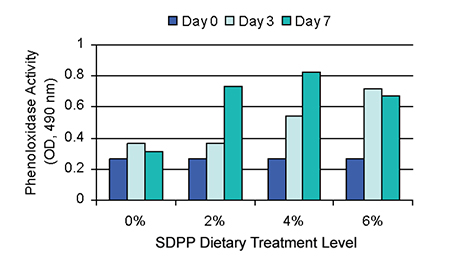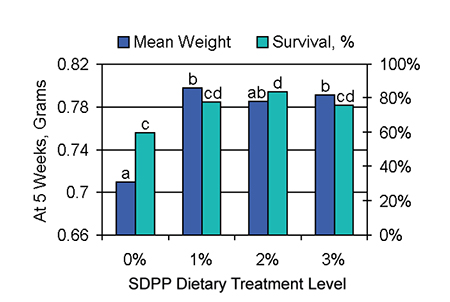Growth and survival of shrimp improved in laboratory and field trials
Spray-dried plasma protein (SDPP) is a high-protein feed ingredient widely used in weaning pig diets, calf milk replacers, and canned pet food. When included in animal diets, growth rate, feed intake and feed efficiency are improved. In addition, the occurrence of enteric disease is reduced when SDPP is used in feed or water.
Over the past year, a series of trials in laboratory tanks and production ponds has been conducted to evaluate SDPP in shrimp feeds. Increased weight at harvest, improved survival rates and greater resistance to disease challenge has been observed.
Effect of SDPP on WSSV challenge

Initially, a series of three trials was conducted under laboratory conditions to determine the protective effect of SDPP during a challenge of White Spot Syndrome Virus. In the first trial, Penaeus japonicus (average weight 13 grams) were assigned to one of four treatments: 0, 2, 4 or 6 percent SDPP. Laboratory tanks (60×30×40 cm) with 15 shrimp per tank were maintained at 25 degrees-C during the 18-day trial. Feed containing Biofend, a patent-pending blend of plasma protein and plasma protein fractions, was offered at 2 percent body weight per day.

On day 8, the shrimp were exposed to WSSV by immersing them in a contaminated tank and then returning them to the original tank. The WSSV challenge was severe, as all the control shrimp (0 percent SDPP) died before the end of the 10-day observation period. However, survival of shrimp that consumed diets containing SDPP ranged from 33 percent to 67 percent (Fig. 1).
Effect of SDPP on shrimp
Two additional trials were conducted in an effort to understand how SDPP impacts shrimp during a WSSV challenge. As in the first experiment, increasing levels of 0, 2, 4 and 6 percent SDPP were added to the feed. Penaeus japonicus were stocked 15 shrimp per tank, in tanks similar to those used in experiment 1. The shrimp were not challenged with WSSV.

Hemolymph samples were collected on days 0, 3 and 7 of the study. The activity of isolated white blood cells was determined by measuring the rate and extent of latex bead phagocytosis as measured by fluorescence microscopy. Initially (day 0), there was no difference between treatments. On days 3 and 7 of the trial, there was an increase in the phagocytic activity of isolated white blood cells that corresponded to increasing levels of dietary SDPP. This is illustrated by percentage of phagocytosis (Fig. 2).
The third trial was similar to the second trial, except that phenoloxidase activity was measured in the hemolymph samples. An increase in phenoloxidase activity corresponding to increasing dietary SDPP was observed on days 3 and 7 (Fig. 3).
Growth test

A short-term (five-week) growth trial under non-challenged conditions was conducted. Penaeus monodon (PL45, 0.43 g initial weight) were housed in 15-l tanks at 15 shrimp per tank, and offered diets top-dressed with 0, 1, 2 or 3 percent SDPP. Weight gain and survival increased with the addition of SDPP (Fig. 4).
Field trial
A field trial compared continuous and intermittent feeding strategies of SDPP. Litopenaeus vannamei were assigned to one of three treatments: 0 percent SDPP, 6 percent SDPP intermittent feeding (every other week), or 6 percent SDPP continuous feeding. Four replicate 0.25-hectare (ha) ponds were stocked with 50,000 animals each and tested for 12 weeks. As exposure to plasma was increased from 0 percent to 6 percent SDPP intermittent to 6 percent SDPP continuous, a linear improvement in survival was observed at 65 percent, 70 percent, and 74 percent, respectively (Fig. 5).

Another field trial compared 0, 2 and 4 percent SDPP fed continuously. Three replicate 1-ha ponds were stocked with 300,000 animals each and tested for approximately 19 weeks. SDPP improved shrimp weight and survival at harvest (Fig. 6). These trials support the continuous use of SDPP when added at the rate of 3 to 6 percent of the feed.
Conclusion

Growth and survival of shrimp improved in laboratory and field trials using dietary supplements of spray-dried plasma protein (SDPP). Research is currently under way to identify the active fraction(s) of SDPP and refine feeding strategies for SDPP under different production conditions.
Research has proven that methods used to process SDPP impact the effectiveness of these proteins. Biofend, the SDPP product administered in each of the noted trials, is developed under strict processing regimens that preserve the quality and effectiveness of this unique blend of plasma protein and plasma protein fractions.
(Editor’s Note: This article was originally published in the December 2000 print edition of the Global Aquaculture Advocate.)
Now that you've finished reading the article ...
… we hope you’ll consider supporting our mission to document the evolution of the global aquaculture industry and share our vast network of contributors’ expansive knowledge every week.
By becoming a Global Seafood Alliance member, you’re ensuring that all of the pre-competitive work we do through member benefits, resources and events can continue. Individual membership costs just $50 a year. GSA individual and corporate members receive complimentary access to a series of GOAL virtual events beginning in April. Join now.
Not a GSA member? Join us.
Author
-
Louis Russell, Ph.D.
Vice President – Research and Development
Joy M. Campbell, Ph.D., Nutritionist
APC, Inc.
Ames, Iowa, USA
Tagged With
Related Posts

Health & Welfare
Broodstock shrimp nutrition, a review
Research into broodstock shrimp nutrition will be a key element in the further use of domesticated and genetically selected stocks for aquaculture.

Aquafeeds
Phospholipids in shrimp feeds
Phospholipids are compounds that combine a water-soluble phosphate group at one end with fat soluble fatty acids at the other.

Health & Welfare
Understanding shrimp hemocytes
Shrimp hemocytes are an important defense against attacks by external agents such as viruses and bacteria. Health diets complement antibacterial action.

Health & Welfare
The oft-overlooked water quality parameter: pH
Attention to pH, a numeric scale used to specify the acid or alkaline condition of an aqueous solution, is very important. Reducing biomass and feeding rates together with phytoplankton control and liming can often keep pH at desirable values.


